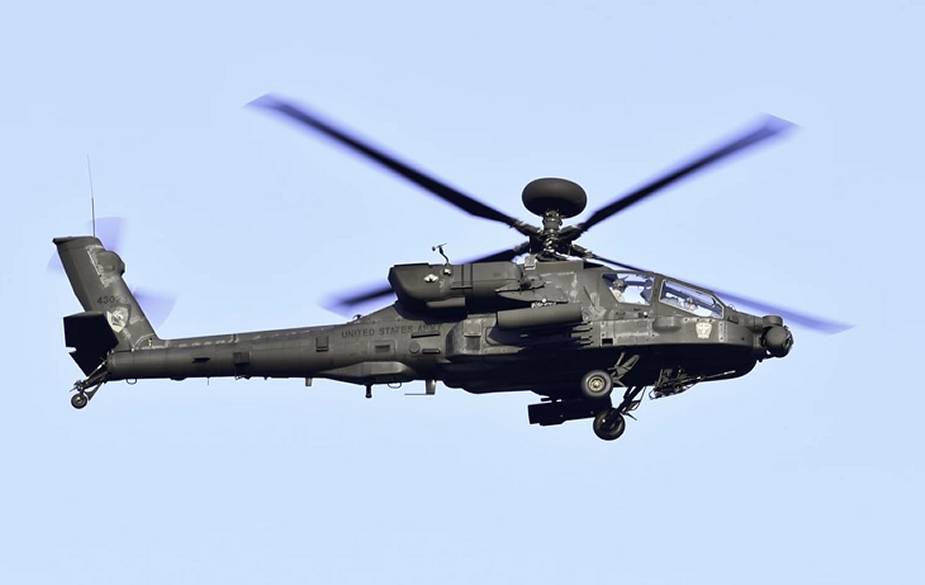Breaking news
Poland willing to buy 96 AH-64E Guardian attack helicopters.
Deputy PM and head of the Polish Minister of Defense Mariusz Błaszczak announced that a request has been sent to the US, regarding the acquisition of 96 AH-64E Guardian (Apache) helicopters. The statement was made via Błaszczak's Twitter account, Jarosław Ciślak reports in Defence 24.com.
Follow Air Recognition on Google News at this link
 The AH-64E version of the Apache is more efficient because it requires less maintenance and can thus evolve longer in a war (Picture source: U.S. Army)
The AH-64E version of the Apache is more efficient because it requires less maintenance and can thus evolve longer in a war (Picture source: U.S. Army)
The request concerns the possible acquisition of 96 AH-64E Apache Guardian helicopters for Army Aviation. Requests as such usually refer to the maximum possible number of units - this is similar to the request sent concerning 500 HIMARS systems.
Boeing has reportedly offered Poland the latest version of the Apache, the AH-64Ev6, which first flew in 2020. The upgrades includea modernized day assembly (MDSA), with a laser rangefinder/designator system, and a new TV sensor and a laser tracker (these components are located in the nose camera of the helicopter) enhanced cognitive decision support system, upgrades of various software and mission system; increased interoperability.
Formerly known as AH-64D Block III, in 2012, it was redesignated as AH-64E Guardian. It has improved digital connectivity, the Joint Tactical Information Distribution System, more powerful T700-GE-701D engines with upgraded face gear transmission to handle more power, capability to control unmanned aerial vehicles (UAVs), full IFR capability, and improved landing gear. New composite rotor blades, which completed testing in 2004, increase cruise speed, climb rate, and payload capacity. Deliveries began in November 2011. Full-rate production was approved on 24 October 2012, 634 AH-64Ds will be upgraded into AH-64Es.
Changes in production lots 4 through 6 include a cognitive decision-aiding system and new self-diagnostic abilities. The updated Longbow radar has an oversea capacity, potentially enabling naval strikes; an AESA radar is under consideration. It will have an L-3 Communications MUMT-X datalink in place of two older counterparts, communicating on C, D, L, and Ku frequency bands to transmit and receive data and video with all Army UAVs. Lots 5 and 6 will have Link 16 data links. The AH-64E is to be fit for maritime use. The Army expressed interest in extended-range fuel tanks for greater endurance.
In fact, this version of the Apache is more efficient because it requires less maintenance and can thus evolve longer in a war.
In addition, Boeing would also have put the MUM-T (Manned UnManned Teaming) capability on the table. It allows an Apache to use multiple drones in one mission. It is also a very recent capability since the United States Army confirmed this capability on October 27, 2020, when the pilot of an Apache took control of an RQ-7BV2 Block 3 Shadow drone in order to guide a Hellfire fired from an MQ-1C Gray Eagle drone.
From 32 to 96 attack helicopters to be purchased
Currently, the Polish Mi-24, Mi-2, and W-3PL helicopters are subordinated to the 1st Army Aviation Brigade, consisting of two elements: 49th Airbase in Pruszcz Gdański, and 56th Airbase in Inowrocław, Jarosław Ciślak report. These should be urgently replaced, and thus Poland is planning to acquire new helicopters. Assuming that a single helicopter squadron includes 16 aircraft, procurement of 96 helicopters would make it possible to fully equip 6 squadrons. These could be a part of the aforesaid bases of the 1st Army Aviation Brigade, but first, they would be assigned to the new 18th Mechanized Division, following an example set by the US Army divisions that also have a helicopter squadron assigned to them.
Noticeably, the Kruk programme initially envisaged procurement of 32 attack helicopters that would replace the two Mi-24 squadrons. The recommendations on the multiplication of the Kruk programme were mentioned in the 2017 Strategic Defence Review, Jarosław Ciślak recalls. At least since 2016, the said programme has been assessed for the emergence of the so-called Basic National Security Interest. Now, a decision was made to follow an FMS route, and to acquire a high number of Apache Guardians. Transfer of Technology is also expected - according to Błaszczak. Undoubtedly, it would be desirable for so significant acquisition to establish a complete maintenance chain domestically, in Poland.


























